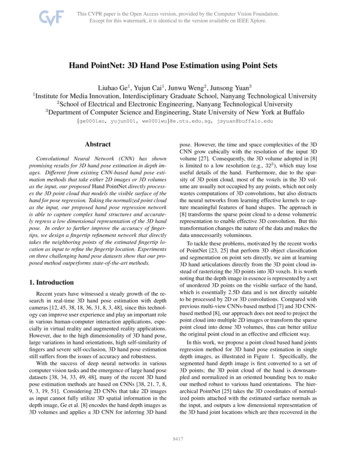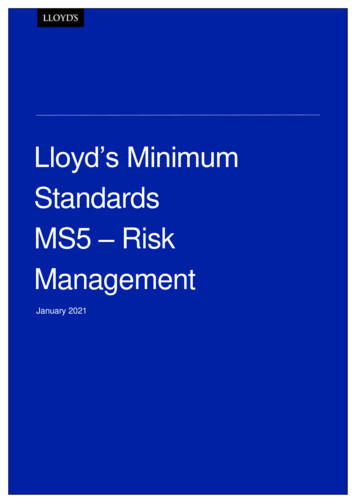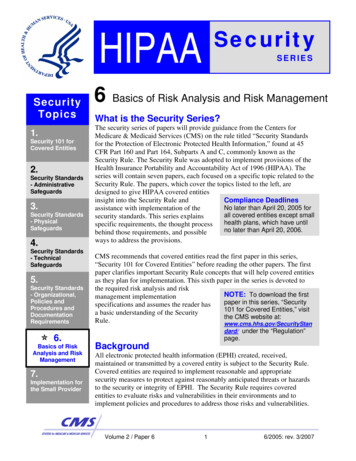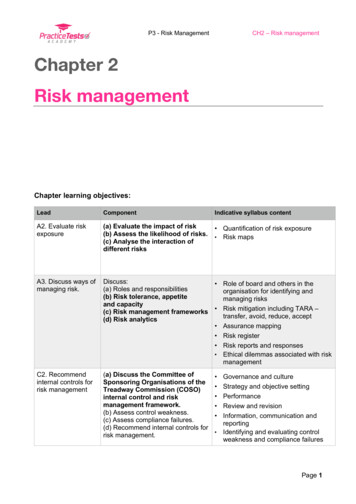
Transcription
Risk Management—the RevealingHandRobert S. KaplanAnette MikesWorking Paper 16-102
Risk Management—the Revealing HandRobert S. KaplanHarvard Business SchoolAnette MikesHEC LausanneWorking Paper 16-102Copyright 2016 by Robert S. Kaplan and Anette MikesWorking papers are in draft form. This working paper is distributed for purposes of comment and discussion only. It maynot be reproduced without permission of the copyright holder. Copies of working papers are available from the author.
Risk Management—the Revealing HandRobert S. Kaplan, Harvard Business School, and Anette Mikes, HEC LausanneAbstractMany believe that the recent emphasis on enterprise risk management function ismisguided, especially after the failure of sophisticated quantitative risk models during theglobal financial crisis. The concern is that top-down risk management will inhibitinnovation and entrepreneurial activities. We disagree and argue that risk managementshould function as a Revealing Hand to identify, assess, and mitigate risks in a cost–efficient manner. Done well, the Revealing Hand of risk management adds value to firmsby allowing them to take on riskier projects and strategies. But risk management mustovercome severe individual and organizational biases that prevent managers andemployees from thinking deeply and analytically about their risk exposure. In this paper,we draw lessons from seven case studies about the multiple and contingent ways that acorporate risk function can foster highly interactive and intrusive dialogues to surface andprioritize risks, help to allocate resources to mitigate them, and bring clarity to the valuetrade-offs and moral dilemmas that lurk in those decisions.1
Risk Management—the Revealing Hand“In a well-functioning, truly enterprise-wide risk management system, all majorrisks would be identified, monitored, and managed on a continuous basis.”-- Rene Stulz 1The combination of financial reporting transgressions in the early 2000s and thefailures of large financial services companies during the global financial crisis of 20072008 has led to legislation and regulations requiring an increased role for enterprise riskmanagement. Some believe, however, that increasing the power and influence of riskmanagement will have an adverse effect by inhibiting innovation and entrepreneurialactivities. Such concerns are not unique to the current era; the developmental economistAlbert Hirschman believed that too much concern about future threats can discouragepeople from undertaking bold new ventures. He introduced a principle, which he called“the Hiding Hand,” that explicitly excused incomplete and inadequate risk assessment. Notdwelling on future threats, he claimed, “can serve as a stimulus to enterprise” byencouraging otherwise risk-averse managers to take on risky projects that in the bright lightof thorough risk assessment would appear infeasible. 2We believe, to the contrary, that planning practices should be guided not by theHiding Hand, but by a Revealing Hand that enables risks to be identified and then mitigatedin a cost-effective manner. Risk management, as stated by veteran NASA systems engineerGentry Lee, is “not a natural act for humans to perform.” Well-documented psychologicaland sociological biases within organizations lead them to overlook important risks and tosystematically underestimate and undermanage those they do identify. 3 When managersare overconfident about their strategies and projects, early identification and discussion of1Rene Stulz, “Risk Management Failures: What Are They, and How Do They Happen?,” Journal of AppliedCorporate Finance, 2008, p. 442The infamous principle of the Hiding Hand has come to epitomize a particular view of entrepreneurship thatsees each project accompanied by two sets of partially or wholly offsetting developments: first, a set of possiblethreats to its profitability and existence (in today’s parlance: risks), and second, a set of unsuspected remedialactions that can be taken once the threats materialize. The logic is that committed to, and caught up in, a projectthat has encountered difficulties, the entrepreneur must mobilize all creative resources and problem-solvingenergy at her disposal. According to Hirschman, there is a dual fallacy that necessitates the Hiding Hand: first,planners tend to underestimate challenges and risks, and at the same time they also underestimate theirorganization’s creative capacity to deal with those challenges. See Hirschman (1967: 15). (Full citations of allarticles cited in the notes are provided in the References at the end of the article.)3Kahneman (2011).2
risks are required to discipline corporate risk-taking and to limit to acceptable levels theexpected consequences from risk-taking behavior. Most policymakers, regulators, andacademics—particularly those who work or specialize in the financial services sector—agree that greater internal clarity about and public disclosure of material risks are likely tolead to better decision-making. But there is far less agreement about how the RevealingHand of risk management should go about this assignment.Some risk management experts embrace a culture of “quantitative enthusiasm.”They believe that the most important role of the corporate risk management function is toidentify and then measure risks. Such risk “quants” rely on their ability to express risks inthe form of statistical distributions, including the correlations among them, for use bycorporate decision-makers when (1) comparing the expected outcomes of riskyalternatives; (2) evaluating the effects of risky investments on the value and risk of thefirm’s entire “portfolio” of assets and businesses; and (3) benchmarking the firm’saggregate risk exposure against its risk appetite.Nassim Taleb and others have provided a forceful critique of this quantitativeapproach to risk management. They note that almost all financial risk models failed duringthe global financial crisis, and in other recent bouts of market volatility, to signal the hugelosses (labeled by Taleb as “Black Swan” events) that occurred with far greater frequencythan expected. 4 The failures of the models led to severe loss of confidence in quantitativerisk managers as an effective Revealing Hand mechanism. If statistical models fail tofunction when they are needed the most, risk management necessarily “changes fromscience to art.” 5The decline of quantitative risk models, however, should not prevent us fromrecognizing the potential value from implementing an effective corporate risk managementfunction. Indeed, admitting that risk management is more art than science helps tointroduce some humility into the risk function—and to the standards that govern thisfunction—that should enable a company’s risk management function to become morereliable and more effective. Such humility begins by recognizing that, among the range ofmanagement disciplines, risk management is one where measurement is particularlydifficult and, indeed, a source of problems in its own right. Measurement generallyinvolves the attempt to quantify events or phenomena that have already occurred or thatalready exist. But risk management addresses events in the future, those that have not yet45Taleb (2007).Stulz (2008: 43).3
occurred and many that may never occur. In many if not most circumstances involving riskmanagement, completely objective measurement is clearly not possible—and thus a largeelement of subjectivity inevitably enters, and often ends up, properly, dominating theanalysis. Financial markets are a partial exception to this observation to the extent that thepast behavior of asset prices can be a reliable predictor of future price behavior. Academicstudies tell us that this is true in general, perhaps more than 99% of the time. But as alreadynoted, all bets are off during major discontinuities, when the Black Swans make theirappearance. During these times, past price distributions and correlations provide littleguidance on the magnitude of risk exposure and how to mitigate it.Since the global financial crisis, many quantitative skeptics, including some fromwithin the financial services sector, have challenged the quantitative risk managers. Theskeptics advocate that effective risk management must go beyond measurable risks toencompass qualitative approaches that will better help managers in thinking about howgood projects and strategies might turn bad, and how their organizations would fare underdifferent scenarios. 6In this article, we examine the scope, the processes, and the consequences of thequantitative and qualitative components of risk management. We begin with the premisethat those seeking to find common ground to reconcile the two approaches can learn fromcases, both inside and outside the financial services sector, of challenges faced by theRevealing Hand of risk management, and how these can be overcome. To advocates andpractitioners of quantitative risk management, the world of current corporate practiceappears messy, political, and gloomy. In an article published in this journal eight years agotitled “Risk Management Failures: What Are They and When Do They Happen?” ReneStulz offered the following assessment:Once risk management moves away from established quantitative models,it becomes easily embroiled in intra-firm politics. At that point, theoutcome depends much more on the firm’s risk appetite and culture thanits risk management models. 7In the pages that follow, we present a somewhat more optimistic view of riskmanagement, one that does not abandon quantitative financial models, but does rely less67Mikes (2009, 2011).Stulz (2008:43)4
heavily upon them. But in providing this moderately optimistic view of risk management,we provide an emphatic caveat emptor: We have studied many man-made disasters, bothin the public and private sectors, and what we have found repeatedly is this: Early warningsigns and risk information were available to operators and decision makers in advance ofthe events, but behavioral biases and organizational barriers prevented the informationfrom being acted on. Despite much talk of “unknown unknowns” and “black swan” events,risk identification appears to be the lesser of two challenges. 8 The principal challenge facedby organizations and their risk managers is their failure to act in the face of accumulating—albeit ambiguous and inconclusive—evidence of an imminent and catastrophic event.Accordingly, one of the major aims of this article is to explore the role, organization, andlimitations of risk identification and risk management, especially in situations that are notamenable to quantitative risk modeling. 9We have conducted multiple studies of organizations whose risk managementsystems have been characterized by both (1) longevity (they had been in existence for atleast five years) and (2) credibility (they had the active support of top management). Wehave tried to understand how risk management tools and processes functioned within thestrategy and operating environment of each company. These examples have helped usunderstand when technology and quantitative models are likely to be productivelyemployed in risk management, and when risk management processes require extensivediscussions and highly interactive meetings as a substitute for objective risk measurement.The Principle of the Revealing HandThe Jet Propulsion Laboratory (JPL), a research and development center thatmanages capital-intensive, time-critical technological projects for the U.S. NationalAeronautics and Space Administration’s (NASA) unmanned space missions, experiencedseveral costly and avoidable failures in the 1990s. 10 Post mortems revealed that JPL’s riskassurance function, among its other shortcomings, was focused on checklists for quality8Turner (1976); Pidgeon and O’Leary (2000).See Stulz (2015); Mikes and Kaplan (2015).10The Mars Climate Orbiter disappeared, during orbit insertion on Sept. 23, 1999, due to a navigation error;analyses had been performed and communicated using English units (feet and pounds) rather than NASAmandated metric units (meters and kilograms). The Mars Polar Lander disappeared as it neared the surface ofMars in December 1999. To save money, the Lander did not have telemetry during its descent to Mars andsubsequent analysis suggested that the failure was probably due to a software fault that shut off the descentrocket too early, causing the spacecraft to fall the last 40 meters onto the surface.95
control, while overlooking many risks—such as errors stemming from engineers workingin English rather than Metric units—that had “incubated” for a long time in functional silos.After the two spectacular failures in 1999, JPL hired veteran aerospace engineerGentry Lee as chief system engineer—in effect the chief risk officer—to develop andimplement a new risk management approach for its planetary and outer space missions.Lee defined his role as “minister without portfolio, the person who made sure everythingworked the way it was supposed to on a global scale.” He described how he thought aboutmission risks: “At the start of a project, try to write down everything you can that is risky.Then put together a plan for each of those risks, and watch how the plan evolves.”This conception of risk management, unusual at the time, flew in the face of theprevious risk culture at NASA, which had been epitomized by the famous 1992pronouncement of chief administrator Daniel Goldin: “Be bold—take risks. [A] projectthat’s 20 for 20 isn’t successful. It’s proof that we’re playing it too safe. If the gain is great,risk is warranted. Failure is OK, as long as it’s on a project that’s pushing the frontiers oftechnology.” 11Goldin’s pronouncement was clearly consistent with Hirschman’s Hiding Handprinciple. As Hirschman advocated,Since we necessarily underestimate our creativity, it is desirable that weunderestimate to a roughly similar extent the difficulties of the tasks we face soas to be tricked by these two offsetting underestimates into undertaking tasksthat we can, but otherwise would not dare, tackle. 12But Hirschman studied public sector officials who lacked confidence and werehighly risk-averse. He wanted the Hidden Hand to instill an optimistic bias so that bold,high-value public investments could be identified and approved.Lee recognized that JPL had exactly the opposite problem of Hirschman’s riskavoiding bureaucrats. Risk-taking at NASA and JPL was rampant, and culturally accepted.It was encouraged, and engrained in the new DNA of the organization, especially afterGoldin’s advocacy of “faster, better, cheaper” missions. Lee believed his principalchallenge was to counter the overconfidence and optimistic bias of his technically verycapable engineering colleagues by revealing to them the actual riskiness of their projects:11Daniel Goldin, transcript of remarks and discussion at the 108th Space Studies Board Meeting, Irvine, CA, 18November 1992; Daniel Goldin, “Toward the Next Millennium: A Vision for Spaceship Earth,” speech deliveredat the World Space Congress, 2 September 1992.12Hirschman (1967): 13)6
JPL engineers graduate from top schools at the top of their class. They are usedto being right in their design and engineering decisions. I have to get themcomfortable thinking about all the things that can go wrong. Innovation—looking forward—is absolutely essential, but innovation needs to be balancedwith reflecting backwards, learning from experience about what can go wrong.Many managers inside NASA, and in many other enterprises regarded riskmanagement as the “business prevention department.” Lee, a principal inspiration for ourformulation of the Revealing Hand principle, believed strongly that risk managementshould not curtail innovation and risk-taking. Rather, rigorous risk management ofinnovative projects should enhance the organization’s innovative capacity and itscapability to accept risky projects, increasing their chance of success. Lee’s disciplinedapproach to risk identification and mitigation was designed to overcome theoverconfidence of innovative project leaders who had never experienced failure in theirprofessional work.Not a Natural Act for Humans to Perform As mentioned earlier, we now have extensive evidence of a general tendency ofindividuals, whether they face uncertainty alone or in large organizations, to place toomuch weight on recent events and experiences when forecasting the future. This leads themto grossly underestimate the range and adverse consequences of possible outcomes fromrisky situations. 13 Nobel laureate Daniel Kahneman contrasts what he calls “System 1thinking,” which proceeds rapidly and is driven by instinct, emotion, and extensivepractice, with “System 2 thinking,” which is deliberate, analytical, and based on evidence.This framework helps explain why risk identification is difficult. People, using theirfamiliar and instinctive System 1 thinking, do not naturally activate the analytical and nonintuitive System 2 thinking required for effective risk management. Managers andemployees, especially under budget and time pressure, become inured to graduallyemerging risks and their System 1 thinking leads them to override existing controls andaccept deviances and near misses as the “new normal”—a behavioral bias that has beengiven the wonderful name of “normalization of deviance.” 14 By treating red flags as falsealarms rather than early warnings of imminent danger, they end up tolerating unknowingly13For studies providing evidence of biases such as “availability,” “confirmation,” “(over)confidence,” and“anchoring,” see Hammond, Keeney, and Raiffa (2006); Kahneman, Lovallo, and Sibony (2011); and Kahneman(2011).14Vaughan (1999).7
an increase in vulnerability to risk events. Companies also make the mistake of “stayingon course” when they shouldn’t. As events begin to deviate from expectations, managersinstinctively escalate their commitment 15 to their prior beliefs, “throw good money afterbad,” and incubate even more risk.In addition to these biases of individuals, organizational biases such as“groupthink” inhibit good thinking about risks. Groupthink arises when individuals, stillin doubt about a course of action that the majority has approved, decide to keep quiet andgo along. Groupthink is especially likely when the group is led by an overbearing,overconfident manager who wants to minimize conflict, delay, and challenges to his or herauthority.All these individual and group decision-making biases help explain why, in theyears running up to the global financial crisis, so many organizations overlooked ormisread ambiguous threats and failed to foresee the huge downside risks to their assetholdings and high leverage. Wall Street banks also hired the “best and the brightest,”people with little if any past experience with failure. Their combination of brilliance,overconfidence, and impatience to succeed led to the creation of innovative, apparentlyhighly profitable, but also highly risky securities in organizational cultures that celebratedand rewarded bold, short-term risk-taking. For example, during a decade of declininginterest rates and macro-economic stability, Stanley O’Neal and Charles Prince, the CEOsof Merrill Lynch and Citigroup, respectively, pushed their companies to take on more riskto avoid being left behind in the race for trading profits. 16Especially in innovative, high-performing companies, it is hard for cost and profitconscious managers to invest more resources in risk identification and risk mitigation,particularly when nothing appears to be broken. 17 Gentry Lee believed he would not havebeen given the authority or resources to install a risk management process at JPL unlessand until a number of NASA’s Mars and shuttle missions ended in catastrophic failures.The Revealing Hand of risk management must be forceful and intrusive to allowindividuals to activate “System 2” careful thinking about risk. It requires intrusive,interactive, and inquisitive processes to accomplish the following: (1) challenge existingassumptions about the world internal and external to the organization; (2) communicaterisk information, aided by tools such as risk maps, stress tests, and scenarios; (3) and draw15Staw (1981).Nocera (2008).17Mikes (2008).168
attention to and help close gaps in the control of risks that other control functions (such asinternal audit and other boundary controls) leave unaddressed, thereby complementing—though without displacing—existing management control practices. As discussed later,the companies that we examined in our case studies deliberately introduced highlyinteractive and intrusive risk management processes to counter the individual andorganizational biases that would otherwise inhibit constructive thinking about riskexposures. In short, they illustrated the Revealing Hand in action.Limitations of Regulated and Standardized Risk ManagementAfter the global financial crisis, consultants and policy makers reached theconclusion that, as articulated by Ernst & Young Partner Randall Miller, “companies withmore mature risk management practices outperform their peers financially.” 18 Consultantsoffered to show less risk-savvy companies how to reap the “likely profit margin increase”that has accrued to “risk management leaders over the last three years” 19 and to achievethe spectacular EBITDA-differentials between the “top” and “bottom” of the riskmanagement maturity scale. 20Despite such claims, academic studies have yet to confirm whether and how riskmanagement practices add value. 21 We can also be skeptical of the universal andstandardized procedures that consultants advocate as best risk management practices. Theirsurveys of contemporary practice document the widespread creation of risk managementdepartments, risk committees and the hiring of specialized staff for these (not surprisinggiven recent regulations and guidelines that mandate, or strongly recommend them). Thesurveys also provide evidence of widespread adoption of risk management tools such asrisk ratings, KRIs, horizon scanning, scenario planning and stress testing. 22 But what theselarge sample surveys fail to provide is convincing evidence of the quality, depth, breadth,and impact of risk management in the adopting organizations.For example, a company may have a risk management department run by aprofessional CRO who has the expressed backing of the CEO and board. But unless thatCRO also has the resources, leadership, and support to reveal the company’s strategy risksproactively and authoritatively, his or her department may be largely ineffective. Simple18EY (,2012).PWC (2015).20EY (2012).21Mikes and Kaplan (2015)22The most popular ones are documented by PWC (2015).199
surveys of practice do not reveal how often risk professionals prevented high risk projectsfrom going forward. Nor do the surveys offer much of a sense of the kind and value ofthe help CROs provide business managers when setting and trying to adhere to the firm’sdeclared “risk appetite.” 23 Not surprisingly, the surveys also document that mandated andcodified risk management practices have not been embraced by corporate managers. 24 Asurvey of C-suite executives reported that fewer than half believed that their organizationhad an effective risk-management program. 25Risk Management ObservedOur bottom-up, inductive approach for understanding effective risk managementprograms sheds light on why risk management is difficult to codify and standardize. InTable 1, we list the case studies that we have studied in detail.Table 1. Risk Management Observed: Cases and ReferencesCaseHydro OneMikes A. (2008).Enterprise RiskManagement at Hydro One(A). Harvard BusinessSchool CaseLEGO GroupMikes A. & Hamel D.(2012). The LEGO Group:Envisioning Risks in Asia(A). Harvard BusinessSchool Case.Jet PropulsionLaboratoryKaplan R. S. & Mikes A.(2010). Jet PropulsionLaboratory. HarvardBusiness School Case.Highlights – learningsRole of risk function: Independent facilitatorScope and skillset of CRO (“the triumph of thehumble CRO”)Action-generation by tools: risk maps and « bang for bucks » indices processes: dialogue and workshops risk-based resource allocationRole of risk function: Independent facilitatorScope and skillset of CRO (“ the triumph of thehumble CRO”)Action-generation by tools: scenarios processes: dialogues and workshops scenario planning linked to annual planning processRole of risk function: Business partnerScope and skillset of CRO (expert, devil’s advocateand decision maker)Action-generation by tools: risk maps processes: risk review workshop (gateway meetings) culture of intellectual confrontation time and cost reserves, tiger teams and humility23Stulz (,2015).RIMS and Advisen (2013).25KPMG (2013).2410
Private BankMikes A., Rose C. S. &Sesia A. (2010). J.P.Morgan Private Bank: RiskManagement during theFinancial Crisis 20082009. Harvard BusinessSchool Case.Corporate Bank(“Wellfleet”,pseudonym)Mikes A. (2009). RiskManagement at WellfleetBank: All That Glitters IsNot Gold. HarvardBusiness School Case.Retail Bank(“Saxon Bank”,pseudonym)Hall M., Mikes A. & MilloY. (2015). How Do RiskManagers BecomeInfluential? A Field Studyof Toolmaking in TwoFinancial Institutions.Management AccountingResearch, 26, 3-22.Role of risk function: Business partner andcompliance championScope and skillset of CRO (expert, devil’s advocatebut not decision maker)Action-generation by tools: risk models and sensitivity analyses processes: face-to-face meetings with traders,weekly asset allocation meetings culture of individual autonomy in risk perception(“everyone must have a view”) dual risk function includes embedded (businesspartner) versus independent (compliance) riskmanagersRole of risk function: Business partner andcompliance championScope and skillset of CRO (expert, devil’s advocatebut not decision maker; compliance champion)Action-generation by tools: risk models and sensitivity analyses processes: face-to-face meetings with relationshipmanagers, credit approval chain, credit risk committee culture of powerful risk voice dual risk function includes embedded (businesspartner) versus independent (compliance) riskmanagersRole of risk function: Business partner andcompliance championScope and skillset of CRO (devil’s advocate but notdecision maker; compliance champion)Action-generation by tools: scenario planning processes: face-to-face, quarterly performancereviews culture of individual responsibility for actiongeneration (“star chambers with CEO”) dual risk function combines embedded (businesspartner) and independent (compliance) risk managers11
Investment Bank(Goldman Sachs)Authors’ Interview withChief Risk Officer CraigBrodercik and ChiefAccounting Officer SarahSmith in New York, 4February, 2010Role of risk function: Business partner andcompliance championScope and skillset of CRO (devil’s advocate but notdecision maker; compliance champion)Action-generation by tools: quantitative risk management enhanced bymark-to-market (fair value) accounting as anindependent “window to risk”; expensiveinfrastructure (people and technology) culture of respect for risk management, “challengeculture”: controllers have final say on valuation, nottraders risk function works closely with accounting andasset management / tradersMany risk management departments operate as independent overseers, with anexclusive focus on compliance, internal controls, and risk prevention. This has been thetraditional domain for risk management, particularly in highly regulated environment.Others, as can be seen in our sample, have moved beyond this to a business partner role.For example, JPL’s risk function influences key strategic decisions, such as approval orveto of new projects, the quantity of resources dedicated to risk mitigation, and a finalrecommendation about whether to go forward with a planned mission launch. Riskmanagement is effective at JPL because the personnel involved in the process have thedomain expertise necessary to credibly challenge the risk-taking project engineers on theirown turf and to interpret and react to changing conditions in and around JPL’s projects.In a third role, the independent facilitator, as practiced at Hydro One and the LEGOGroup, the risk managers do not influence formal decision-making. Rather, they set theagenda for highly interactive risk management discussions and facilitate thecommunication of risk up, down, and across the organization. In this role, the CRO needsstrong interpersonal and communication skills but not, necessarily, a high level of domainexpertise. These CROs must operate with a degree of humility to stimulate broad and wideranging discussions that develop qualitative and subjective risk assessments. 26 Suchassessments, in turn, help senior line managers set priorities among operational andstrategy risks and allocate resources to mitigate them.Working with limited formal authority and resources, this kind of humble,facilitating CRO builds an informal network of relationships with executives and business26Mikes (forthcoming)12
managers, with the aim of being neither reactive nor proactive while maintaining a carefulbalancing act between keeping one’s distance and staying involved. Even without formaldecision-making authority, the risk discussions facilitated by the humble risk manager areconsequential; they identify, “map” and (to the extent possible) quantify risk exposures,and influence decisions and resource allocations by line managers who ultimately mustexecute risk management within their operations and authority. 27The apparent success of this independent facilitator model of risk managementsuggests that calls for increasing investments in risk management and for the formalinclusion of senior risk officers in the C-suite could be misguided. Many companies willbe best served when the Revealing Hand of risk managemen
studies tell us that this is true in general , perhaps more than 99% of the time . But as already noted, all bets are off during major discontinuities, when the lack B Swans make their appearance. During these times, past price distributions and correlations little provide guidance on the magnitude of risk exposure and how to mitigate it.











